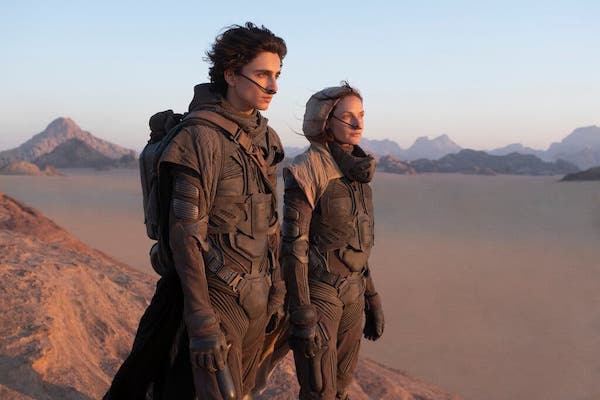Actors, visuals, soundtrack dazzle in “Dune”

Image courtesy of Warner Bros.
Lady Jessica (Rebecca Ferguson) stands alongside Paul Atreides (Timothée Chalamet) in “Dune”, which premiered in theaters on October 22nd.
You can feel sand and see the light of pounding explosions right in front of you and hear the buzz of dragonfly choppers mixed with chanting voices.
This is the experience of watching “Dune,” directed by Denis Villanueve (Arrival and Blade Runner 2049), the first in a trilogy of movie adaptations of Frank Herbert’s 1960s novels.
The film is set thousands of years in the future as Paul Atreides, played by Timothée Chalamet, and his family arrive on the planet Arrakis. His father, the Duke (Oscar Issac), will soon become the leader of Arrakis at the wishes of a mysterious emperor. Arrakis is also the home of the valued resource and hallucinogen Spice and is inhabited by the Fremen people but has been colonized by the evil House Harkonnen.
The film’s immersiveness is created by stellar performances from A-List actors, dazzling costume design, and meticulous visuals that transport viewers to vast sand landscapes and intricate architecture, captured by various camera angles, textures, and lighting.
The effect is otherworldly and strange, but the settings also feel familiar because most of “Dune” was filmed in the desert of Wadi Rum, located in Jordan–only two scenes in the film were shot using green screen, according to Chalamet.
“They didn’t shoot ‘Jaws’ in a swimming pool,” Villanueve said in a conversation with Stephen Colbert. “We needed to be in the real environment, so we will be inspired by the infinity,”
The soundtrack is composed by Hans Zimmer, who “had been thinking about ‘Dune’ for nearly 50 years” and spent a week in the Utah desert listening to sounds such as “the wind howling,” according to the New York Times.
Synthesizers and thumping drums are coupled with odd sounds from scraping metal, distorted guitar, Irish whistles, and Indian bamboo flutes as the volume rises and falls for a usual yet unforgettable full-body journey.
This music perfectly accompanies the on-screen action, such as combat. Choreographer Roger Yuan used the Filipino martial art technique, Balintawak Eskrima, to make combat scenes feel “like a dance performance,” according to Villanueve.
Along with closer combat, larger fight scenes also stand out. Colonizers fight for control of the planet to violently extract its resources, mainly Spice, while the native population of the planet, the Fremen, are ignored or massacred. Paul Atreides is hailed as a white “messiah,” and invaders from House Harkonnen and House Atreides are dressed in European-style costumes, while Natives wear hijab and djellaba and are played by Indigenous and Black actors.
This paints an allegory for colonialism and imperialism and depicts the harm they cause to Arrakis’ environment and people. Villanueve, in an interview with Variety, stated, “The impact of colonialism, the exploitation of natural resources, the danger of mixing politics and religion together, the danger of messianic figures are more vibrant and present in our societies. So, I think sadly, the book is more relevant today than it used to be when it was written”.
Overall, “Dune”’s relevance and immersive experience make it worth the watch, and audiences have rated it at 90% on Rotten Tomatoes. Viewers are left anticipating the future of “Dune,” with both the trailer and the movie leaving some questions unanswered, such as the fate of the mysterious Chani, played by Zendaya and seen in fleeting glances. The second installment of the series has already been announced, so viewers can look forward to returning to Arrakis.

Harper Axelman is a senior at AHS and this is her third year writing for The Skier Scribbler. She enjoys spending time outside, skiing, and...
































